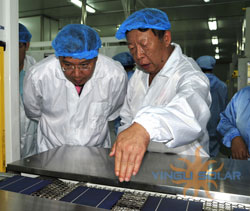Yingli expects 2nd place finish to spur sales
 Yingli Green Energy Holdings believes the results of a recent third-party test will lead to strong growth opportunities for the company.
Yingli Green Energy Holdings believes the results of a recent third-party test will lead to strong growth opportunities for the company.
Yingli Solar announced that its PANDA solar module ranked second in the 2011 TUV Rheinland Energy Yield Test among 14 modules from 11 solar photovoltaic panel manufacturers that were tested.
“The TUV Rheinland Outdoor Performance test has been specifically recognized for its objective and thorough assessment of PV module performance,” said Brian Grenko, director of operations for Yingli Americas. “So, of course we are excited about the results of this test, which demonstrate the superior energy yield performance of Yingli Solar PV modules.”
The TUV Rheinland tested solar modules under high temperatures and low irradiation from Sept. 1, 2011 to Aug. 31, 2012.
Yingli’s PANDA module output about 0.6 percent less energy than the top performer, 2.9 percent than the average and 5 percent more than the lowest-ranking modules, according to a release from the company.
Grenko said the recognition will validate the PANDA module purchases for clients who have already made the investment – There are several hundred megawatts of the module already deployed – and will likely encourage those potential clients who have been weighing the module as an option to consider it more seriously.
“We anticipate sales of this product to continue growing,” Grenko said, “particularly for those applications where space is limited and higher efficient products are required.”
Yingli introduced its PANDA module in 2010. It’s manufactured with monocrystalline n-type bulk silicon using mostly conventional solar production equipment, Grenko said.
“As a result, PANDA PV modules have a higher conversion efficiency, and perform better under high temperature and low irradiance conditions, with less degradation,” Grenko said.
Yingli entered its standard module in the 2010 test. That model also came in second, Grenko said. And sales grew afterward. The market for the PANDA module might be more specific.
“The superior performance of PANDA PV modules in high temperature and low light conditions makes the technology particularly attractive for projects in locations with high insolation and markets with attractive financial incentives for generation,” Grenko said, “specifically those that reward higher production in early evening hours, when demand often peaks.”



